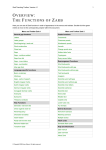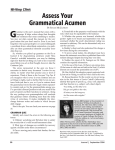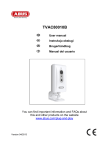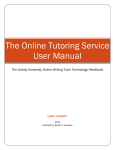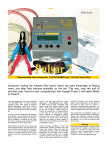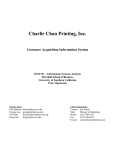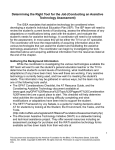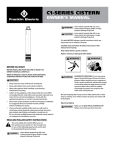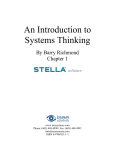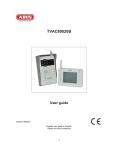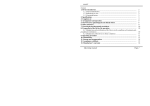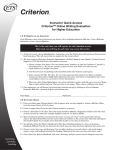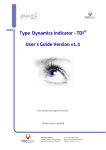Download Setting the Context for Understanding.
Transcript
Setting the Context for Understanding July 30, 1993 Bradford R. Connatser 1926 Jackson Road Knoxville, TN 37921 (615) 584-5154 INTRODUCTION Once Upon a Phrase “Once upon a time” is probably the most successful rhetorical phrase ever articulated. Those four little words speak volumes. They introduce the genre, set the mood, establish setting—they set the context for understanding the succeeding prose. “Once upon a time” means “I’m about to tell you about something magical that happened in a far-away time and place—prepare to be enchanted.” What a shame the genre of technical writing has no cache of ready phrases for setting contexts. Perhaps because we technical writers must erect fences around our creative impulses, expository writing is often counterintuitive, frustrating. Whereas creative writing such as the fairy tale captures the spontaneity and unpredictability of human existence, expository writing tames experience, reorganizes it, makes it consistent and logical. Surprising the reader is out; bowing to expectations is in. What effective technical writing does have in common with the fairy tale genre is an apparent simplicity. However, as any technical writer knows, making things simple can be very difficult. Experience is so fluid, so complex. It’s often wonderful how one inconceivable moment eddies into another. Yet it’s often frustrating to channel those eddies of complexity into a logical stream, a sequence of moments spliced together with artificial connectives. We technical writers have set a tall order for ourselves: to take associative experience and turn it into the sequential, coherent, and sometimes rigid narrative the audience expects. One primary obligation of the technical writer, then, is to determine with precision the knowledge base and needs of the intended audience. Questions about the audience are the tuning forks of our profession. Reader-Oriented Syntax Basically, writer-oriented syntax ranks the elements of composition by their value to the writer; reader-oriented syntax ranks the elements by their value to the reader. Because we technical writers must satisfy the needs of the audience, we should use reader-oriented syntax. Consider this commonplace example of writer-oriented syntax: “Press Enter to exit.” The prose has two basic elements: an action and a result of that action, or cause and effect. The proper arrangement of these elements is too often an omitted criterion for successful communication. The writer values the logical cause-and-effect context of this example because the logical relationship between action and result typifies the way software works. Mistakenly assuming that the reader values the logical cause-and-effect context above all (or, worse, not considering the needs of the audience at all), the writer crafts the prose in a logical order. However, what does the reader really value most in this example? Understanding the logical relationship between action and result is certainly important, but more important to the reader are her or his options. Now consider that “Press Enter to exit” is designed for someone who does not know that pressing the Enter key closes the software application. “Press Enter” is a command; “to exit” is a trailing qualifier. A reader eager to follow directions may press “Enter” even if she or he does not want to exit. In such a case, the reader is deprived of the proper context for understanding the options. Writer-Oriented Syntax Cause press Enter Reader-Oriented Syntax Effect to exit Option to exit page 2 How to Select Option press Enter The reader values options, which are commonly indicated by infinitive phrases such as “to exit.” The writer remembering the obligation to discover the needs of the intended audience should have valued the context of options above all: “To exit, press Enter.” To exit or not to exit? That’s the context. THE EMPATHIC WRITER A Metaphoric Audience As a student writer at Temple University, I had the pleasure of reading an excerpt from The Day Language Came into My Life, by Helen Keller. At that time, I was teaching technical writing to undergraduate students. Because I was struggling with a way to teach reluctant students to resist self-indulgent prose and consider the audience, I was struck by a particular sentence from that excerpt. “On that afternoon of that eventful day,” Keller wrote about her anticipating the arrival of Anne Sullivan, “I stood on the porch, dumb, expectant.” The sentence was revelatory, to me the most apt metaphor for technical writing imaginable. Helen Keller stood there on her porch, without a context for understanding, without a ready language, waiting for someone to reveal extra-experience. “She is the archetypal audience,” I thought. Although the metaphor wafted over my students like a somnolent breeze, I still cling to its accuracy. To me it is substantial. Like Anne Sullivan, we technical writers must come to our audience. We must build a context for understanding. We must adjust language to fit the needs of the audience, as Miss Sullivan did when she tactually gestured into the expectant palm of Helen Keller. We must take the reader by the hand and lead the reader to understanding: that is the ethos of our profession. page 3 Rhetorical Confidence Coming to the audience, adjusting language to fit the needs of the audience should not be considered a mere act of submission. Rather it is an act of rhetorical confidence. When writers know their subjects and sincerely commit to clear communication, they need not play the game of “creative integrity,” which simply means that the writer refuses to change “inspired” language because she or he lacks the confidence that comes from knowledge and commitment. Writers who do not consider the audience but write bravely do not demonstrate rhetorical confidence but rhetorical hubris. While reading a complicated text, we have all from time to time found ourselves lost within a sentence, “in the dark,” blundering into unidentifiable structures, groping for meaning. If the text is published, we feel frustrated, inadequate, alienated—not in awe of the writer, who has merely succeeded in confounding us. If we come across such a text while wearing our editor’s cap, we grow angry at the author of self-indulgent prose; it means more work for us. Take this example from “Différance,” an essay by the philosopher Jacques Derrida. The essay begins: “I will speak, therefore, of a letter.” The inauguration of his essay is brave, the continuation of a brilliant dialogue in Derrida’s mind to which we are not privy. “Therefore” indicates the conclusion of some thought, but we have just begun to read. Perhaps more than anything, this is an example of private discourse. The reader merely overhears. The reader is an eavesdropper, an outsider. We must have the rhetorical confidence to give the audience confidence, to make the audience feel comfortable with the text. Such rhetorical confidence comes from fully understanding the subject, purpose, and audience. If the reader feels confident while reading your prose, if she or he does not have to reach for meaning, then you have consummated the first goal of technical writing: to establish an authentic relationship with the reader. page 4 SETTING THE CONTEXT The Ballad of the Context Qualifier All writing is about human psychology. A carefully crafted report of test results is just as human as a narrative about young love: They both satisfy human curiosity and desire for experience, for knowledge. The medium of the technical writer resists transformation no less than the medium of the creative writer. Technical writers must struggle against words to create experience for the reader. The idea is not romantic, the struggle is not celebrated, minstrels do not compose ballads of the technical writer suffering over an incomplete user manual. We have only the efficacy of our work as reward. When a writer commits her- or himself to precision, all the little diligently orchestrated details contribute to readability. The cumulative effect can be very rewarding. For crafting and editing the sentence, we all have our little inculcated checklist: clarity, concision, economy, consistency, and so forth. However, from reading and studying what I would call bad examples of expository writing, I have discovered one criterion for success routinely omitted from the checklist of their authors: a readeroriented trajectory of meaning, better known as context. Within a sentence, contexts hinge on connectives, sometimes called ligatures: conjunctions, prepositions, conjunctive adverbs, relative pronouns, correlatives, transitional expressions, adjectival phrases, the to in infinitives. The list of connectives can be further divided into psychological registers: • Temporal (when?)—at, during, after, as • Spatial (where?)—in, about, up • Sequential (in what order?)—next, finally, therefore • Logical (why?)—because, if, lest page 5 • Modal (how?)—by, through, according to You can add or subtract from this list. The point is, connectives orient the readers by answering their potential questions, and they allow writers to qualify contexts. The Essence of the Context Qualifier There are basically three types of context qualifiers: • the non-essential qualifier, which can be placed anywhere in the sentence without shifting the context • the essential qualifier type 1, which belongs at the beginning of the sentence • the essential qualifier type 2, which defies re-arrangement because of a syntactic limitation. The Non-Essential Qualifier. When a qualifier adds meaning to the context but does not shift it, the qualifier can be placed anywhere in the sentence. Most of the qualifiers in this category are logical or modal: they tell us why or how. Consider this example. The current waveform is smoother than the voltage waveform because the internal impedance contains inductive elements. Here, the “because” clause qualifies the independent clause, which in this context is an absolute statement. Acting as an adverb, the qualifier tells us “why”; it does not shift the context and is therefore non-essential in its sentence. However, it is extremely important to the larger context, one that encompasses the sentence. As a matter of fact, because the sentence refers to an illustration, one may consider the qualifier more important than the clause it qualifies (which repeats the information in the illustration). Such an analysis page 6 may justify placing the qualifier at the beginning of the sentence; but, again, the qualifier does not shift the context and therefore does not have to go at the beginning. Now let’s tweak the example. Suppose we change because to when. Now the context is no longer absolute but conditional. The current waveform is smoother than the voltage waveform only when something else is true. The context for understanding the independent clause now depends upon the context qualifier. By changing because to when, we have created a sentence with an essential context qualifier, which should go at the beginning of the sentence. Otherwise, the reader would have to re-evaluate the main clause and adjust its meaning to fit the new context. Sometimes, determining whether the qualifier is essential or non-essential can be difficult. Consider this example. The ac source line normally feeds the load while the inverter delivers power to the battery. If you are the writer of this sentence, you know what you mean. For the reader, however, the sentence may seem ambiguous. Here, while can mean either “during the time that” or “whereas.” If we say that while means “during the time that,” then the qualifier is conditional—essential—and should go at the beginning of the sentence. If we say that while means “whereas,” then the qualifier supplements the meaning of the main clause—it is non-essential. Remembering the rule for punctuating non-essential elements, then, we should add a comma after load. The comma breaks the misleading appearance of contextual dependence between the two clauses. However, only the writer knows what while means in this context; he or she did not come to the reader, who must reach for meaning. page 7 The Essential Qualifier Type 1. This type of context qualifier should be placed at the beginning of the sentence to orient the reader. However, one may encounter it in one of three positions within a sentence. • Direct. The qualifier is placed at the beginning of the sentence, where it belongs. As of November 28, 1988, this warning was not required to be in advertisements. • Suspended. The qualifier is placed at the end of the sentence. In creative writing, qualifiers can be delayed for effect. In expository writing—especially technical writing—language should be “invisible.” That is, the words should not bring attention to themselves; meaning should be evident; setting the proper context should not be sacrificed in favor of creative psychological effects. Suspended: Performance, reliability, and cost are high-priority issues, when sensitive electronic equipment is purchased by the end user. Direct: When sensitive electronic equipment is purchased by the end user, performance, reliability, and cost are high-priority issues. • Interpolated. The qualifier is placed somewhere in the middle of the sentence, “between the poles.” An interpolated qualifier may seem sophisticated, but is usually a barrier to meaning, against which the reader blunders. Also, interpolated qualifiers often awkwardly separate the subject from the verb. Interpolated: The Team Leader with assistance from the Lab Supervisor and the Lead Engineer identifies any collaborators required for the project. page 8 Direct: With assistance from the Lab Supervisor and the Lead Engineer, the Team Leader identifies any collaborators required for the project. The Essential Qualifier Type 2. Sometimes we have to indulge in syntactic gymnastics to develop complex relationships within a sentence. For instance, when we bond two or more conditional elements within a sentence, both elements placed at the beginning of the sentence may be awkward, even though they both qualify as essential. If you want to automatically hyphenate your text, press the Enter key when the dialogue box appears. Here, it would be awkward to place both qualifiers at the beginning of the sentence, and wrong to place them at the end. We could split the sentence in two, or shuffle parts of it into the preceding or succeeding sentence. My argument for leaving the sentence as it is? The reader’s acting before reading the second qualifier is benign. The conditional introductory clause sets the proper context—it gives the reader her or his options. Pressing Enter before the dialogue box appears yields the same results. Options—A Derelict Context Think back to the “Press Enter to exit” example and consider how it invites misreading. Many of the most egregious examples of technical writing come from instruction manuals and on-line instructions. Too often the writer of instructions denies the reader her or his options. Look at this example of instructions for an electronic organizer. The delete prompt appears. Press Y. To keep the schedule, press N. page 9 This is a flagrant example of writer-oriented syntax. The writer is eager to demonstrate how to delete a file, but again the reader wants options, especially during a procedure as potentially irreversible as deleting records. Further, the command most likely to result in irreversible operator error (“Press Y.”) should succeed all other commands (“. . . press N.”). Now, let’s revise this mess. The delete prompt appears. To keep the schedule, press N. To delete the schedule, press Y. The writer of instructions must also decide whether the qualifier is essential or nonessential. Let’s look at an example from cooking instructions for a microwave dinner. Loosen film from chicken portion only to vent. Let’s forget that the articles are missing so that the sentence reads like Tarzan said it. Let’s also forget that the modifier only is misplaced. Instead, let’s focus on the qualifier “to vent.” To vent or not to vent—is that the context? If so, then “to vent” certainly belongs at the beginning of the sentence to create a context of options for the reader. In this example, however, “to vent” is a polite gesture to inform the curious who ask, “Why do I have to loosen the film?” There’s no option here, and therefore the qualifier can be placed at the end without shifting the context. Right Instinct, Wrong Approach Often the writer’s instinct is correct: Set the proper context for understanding. Yet even when the instinct is right, the effort to set a context can lead to grammatical errors and page 10 clumsy construction. Dangling participial phrases, left-branching series, and imprecise connectives sometimes do more harm than good. Dangling Participial Phrases. Setting the context with an introductory participial phrase, especially one with a present participle, takes a thorough knowledge of the rules of syntax. Consider the following example, the author of which had the right instinct but the wrong approach. Recognizing the increasing global nature of manufacturing technology innovations in the industrial sector, new international partnerships provide the program with enhanced opportunities for technology transfer and development. Here, Recognizing does not modify anything in the sentence and therefore dangles. Although the author has created a grammatical error, the effort to build a proper context for understanding is praiseworthy. Because this sentence is long, the proper way to covey its message is to break the sentence into two clauses, a dependent and a relative. The program recognizes the increasing global nature of manufacturing technology innovations in the industrial sector by creating new international partnerships, which provide the program with enhanced opportunities for technology transfer and development. Left-Branching Series. Deciding where to place items in a series within a sentence can be a hair-pulling exercise, especially if the items are numerous (more than three items), long (phrases and clauses), or unwieldy (items with internal punctuation). Consider the page 11 following example of a “how” context qualifier—a left-branching series that dams the sentence. For example, via our exclusive 800 number, network, publications, videos, customer services, and Centers/Offices, technical support can be obtained. Here, the series constipates the sentence and retards meaning. The confusing syntax also distorts the reader’s comprehension of each word’s function in the sentence. Where does the subject start and the object(s) of the preposition via end? The reader may misread “network, publications, videos, customer services, and Centers/Offices” as the subject. Here, placing the qualifier in front of the main clause certainly does more harm than good. The remedy? Use the right-branching series. For example, technical support can be obtained via our exclusive 800 number, network, publications, videos, customer services, and Centers/Offices. Imprecise Connectives. Every connective has precise meanings. Some connectives are synonymous and can be used interchangeably; most are not. The writer must choose a connective that accurately indicates the relationship between parts of a sentence. For a reason I do not understand, writers shun the word because, even when the word precisely fits the context. Words such as with, as, and since often take its place. Consider the following example of an imprecisely used connective. page 12 With increasing emphasis on the environment and efficiency, major projects include textile, food processing, pulp and paper water treatment, textile ultrasonic dyeing, and mechanical pulping research. Kudos to the writer of this sentence for trying to set a context and using the rightbranching series. Yet it is clear that the writer did not commit her- or himself to precision. What is the relationship between the “increasing emphasis on the environment and efficiency” and the rest of the sentence? Logical, cause-and-effect. If we begin the sentence with “Because of” instead of “With,” we set the proper context for understanding. CONCLUSION Technical writers should not consider themselves rule-bound but peer-enabled. Try the rules, the gimmicks, the tricks, the suggestions that make your writing work for the reader. Abandon the ones that sound official but make sense only on an abstract, theoretical plane of thought. Be skeptical about conventions and rules. Is a passive contruction really so offensive to the reader? And what about those copulative verbs? No one, not even Richard Lanham, has convinced me yet that using forms of the verb to be works much the same as using a sleeping potion. Nothing is absolute. Sound technical writing is not an accumulation of precise technical decisions; it’s much more messy than that. Nor is it an accumulation of creative impulses. A writer friend of mine once claimed that sound technical writing is nothing more than a generous amount of common sense applied to the uncommon. But such a definition oversimplifies our complex craft. Although I am unable to offer a profile of the consumate technical writer, I do know that the best writers have an uncommon sense that allows them to wear the skins of their audiences and anticipate reactions. To write page 13 more the way readers actually read and write less the way we want readers to read, we must construct for them proper contexts for understanding. page 14
















